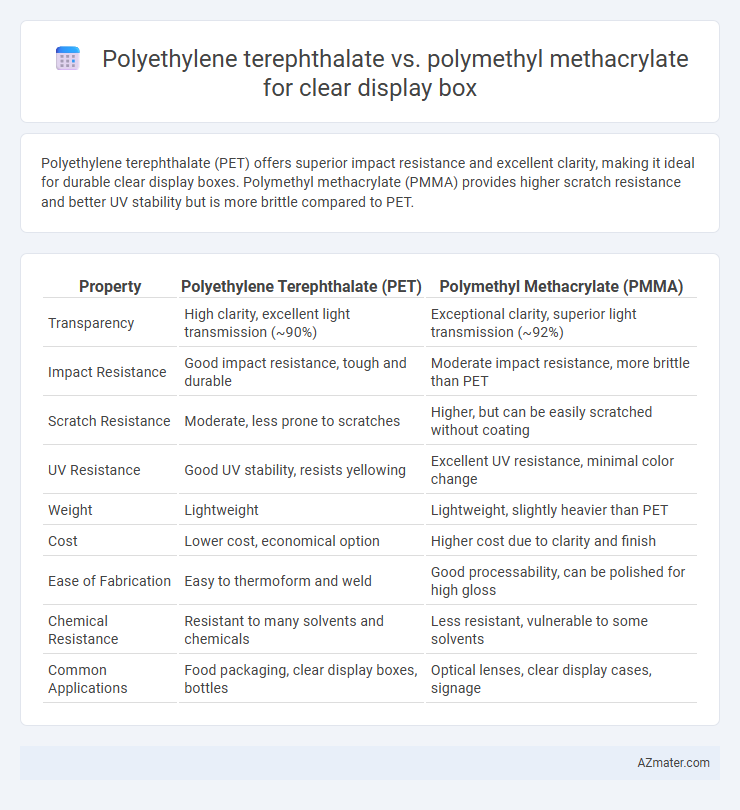Polyethylene terephthalate (PET) offers superior impact resistance and excellent clarity, making it ideal for durable clear display boxes. Polymethyl methacrylate (PMMA) provides higher scratch resistance and better UV stability but is more brittle compared to PET.
Table of Comparison
| Property | Polyethylene Terephthalate (PET) | Polymethyl Methacrylate (PMMA) |
|---|---|---|
| Transparency | High clarity, excellent light transmission (~90%) | Exceptional clarity, superior light transmission (~92%) |
| Impact Resistance | Good impact resistance, tough and durable | Moderate impact resistance, more brittle than PET |
| Scratch Resistance | Moderate, less prone to scratches | Higher, but can be easily scratched without coating |
| UV Resistance | Good UV stability, resists yellowing | Excellent UV resistance, minimal color change |
| Weight | Lightweight | Lightweight, slightly heavier than PET |
| Cost | Lower cost, economical option | Higher cost due to clarity and finish |
| Ease of Fabrication | Easy to thermoform and weld | Good processability, can be polished for high gloss |
| Chemical Resistance | Resistant to many solvents and chemicals | Less resistant, vulnerable to some solvents |
| Common Applications | Food packaging, clear display boxes, bottles | Optical lenses, clear display cases, signage |
Introduction to Clear Display Box Materials
Clear display boxes commonly utilize Polyethylene terephthalate (PET) and Polymethyl methacrylate (PMMA) due to their excellent transparency and durability. PET offers superior impact resistance and flexibility, making it ideal for protective packaging, while PMMA provides higher optical clarity and UV resistance, suitable for premium display cases. Selecting between PET and PMMA depends on factors such as cost-effectiveness, intended use, and required strength for the display environment.
Overview of Polyethylene Terephthalate (PET)
Polyethylene terephthalate (PET) is a strong, lightweight, and transparent thermoplastic commonly used for clear display boxes due to its excellent clarity and high impact resistance. It offers superior chemical resistance and is highly recyclable, making it an environmentally friendly option compared to other plastics. PET's durability and ability to maintain a clear appearance over time make it ideal for packaging and showcasing retail products.
Overview of Polymethyl Methacrylate (PMMA)
Polymethyl methacrylate (PMMA) is a transparent thermoplastic often used as a lightweight, shatter-resistant alternative to glass for clear display boxes, offering excellent optical clarity with light transmittance around 92%. Compared to polyethylene terephthalate (PET), PMMA provides superior UV resistance and better weatherability, making it ideal for long-term display applications exposed to sunlight. Its hardness and scratch resistance contribute to maintaining a pristine visual presentation, while its ease of fabrication supports custom designs in retail and exhibition environments.
Clarity and Optical Properties Comparison
Polyethylene terephthalate (PET) offers higher clarity with a light transmittance of approximately 90%, making it ideal for clear display boxes requiring bright, vivid visibility. Polymethyl methacrylate (PMMA), also known as acrylic, provides superior optical properties with excellent light diffusion and a refractive index of 1.49, resulting in sharper and more brilliant displays. While PMMA exhibits better scratch resistance and UV stability, PET balances durability and cost-effectiveness with slightly lower optical clarity.
Strength and Durability Differences
Polyethylene terephthalate (PET) offers excellent impact resistance and tensile strength, making it highly durable for clear display boxes subjected to frequent handling and potential drops. Polymethyl methacrylate (PMMA), while providing superior optical clarity and scratch resistance, is more brittle and prone to cracking under stress compared to PET. For applications demanding higher strength and long-term durability, PET is generally preferred over PMMA despite the latter's better aesthetic qualities.
Weight and Handling Considerations
Polyethylene terephthalate (PET) is significantly lighter than polymethyl methacrylate (PMMA), making it an ideal choice for clear display boxes that require easy handling and portability. PET offers superior impact resistance and flexibility compared to PMMA, which tends to be heavier and more brittle, increasing the risk of cracks or breaks during handling. Weight savings with PET contribute to reduced shipping costs and enhanced user convenience without compromising clarity or durability.
Chemical Resistance and Environmental Impact
Polyethylene terephthalate (PET) exhibits superior chemical resistance to acids and alkalis compared to polymethyl methacrylate (PMMA), making PET more suitable for clear display boxes exposed to harsh cleaning agents. PMMA offers better resistance to UV degradation but is more susceptible to solvents, leading to surface crazing and reduced durability. Environmentally, PET is highly recyclable and has a lower carbon footprint due to efficient recycling processes, whereas PMMA recyclability is limited and its production involves higher energy consumption and emissions.
Cost Efficiency and Market Availability
Polyethylene terephthalate (PET) offers superior cost efficiency compared to polymethyl methacrylate (PMMA) for clear display boxes due to its lower raw material and production expenses. PET is widely available in the market, benefiting from a robust supply chain and extensive recycling infrastructure, enhancing its economic appeal. In contrast, PMMA, while providing excellent optical clarity and scratch resistance, tends to have higher costs and more limited availability, making it less favorable for budget-conscious applications.
Common Applications and Use Cases
Polyethylene terephthalate (PET) is widely used in clear display boxes for packaging electronics, cosmetics, and food products due to its excellent clarity, high impact resistance, and recyclability. Polymethyl methacrylate (PMMA), known as acrylic, offers superior optical clarity and UV resistance, making it ideal for high-end retail displays, museum cases, and signage requiring long-term aesthetics and durability. Both materials provide transparency but PET is favored for mass-market, cost-effective packaging, while PMMA is preferred for premium presentations and outdoor applications.
Final Recommendation: Choosing the Right Material
Polyethylene terephthalate (PET) offers excellent clarity, high impact resistance, and superior moisture barrier properties, making it ideal for clear display boxes requiring durability and product protection. Polymethyl methacrylate (PMMA), known for its exceptional optical transparency and UV resistance, provides a glass-like appearance but is more prone to cracking under stress. For clear display boxes prioritizing impact resistance and moisture protection, PET is the recommended choice, whereas PMMA suits applications demanding enhanced aesthetic clarity and weather resistance.

Infographic: Polyethylene terephthalate vs Polymethyl methacrylate for Clear Display Box
 azmater.com
azmater.com